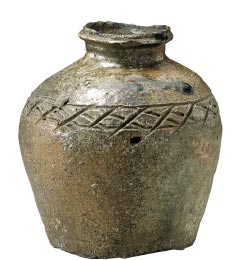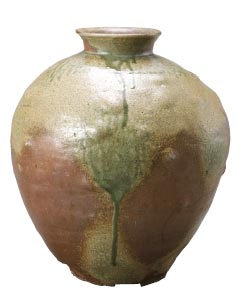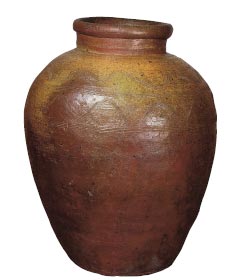
|
Shigaraki
|
||
The
Shigaraki kilns, dotted across the town of Shigaraki in Koka
City, Shiga Prefecture, also primarily produced pots, jars,
and large bowls, like the other kilns. However, as the last
kiln site of the medieval period, its products circulated
primarily in Nara and Kyoto. From the Nanbokuchō period,
Shigaraki began to create its own distinctive features. Jars
with thick incised lines encircling the inner rims, pots
with out-turned, double rims, as well as small and large
pots with fence patterns that could be seen only on
Shigaraki ware appeared. It can be said that of the many
medieval ceramics, Shigaraki ware possesses, above all, the
richest expressions. As if imitating the abundant nature of
Japan from season to season, Shigaraki captures the hearts
of its viewers with its unique expressions, such as its
burnt surface, magnificent water fall-like drippings of
natural bright green ash glaze, rich flaming red hues
contrasting light and dark, coarse surfaces like wind and
rain-trodden, withered fields, and bursting crab eye-like
feldspars.
|
|||

|
Tamba
|
||
Situated in the region from the north to east of Imada in
Sasayama City, Hyogo Prefecture, Tamba was another
prosperous kiln site that was influenced by Tokoname ware.
This influence is strongly pronounced in early examples from
Tamba, however, from the 14th to 15th century, Tamba ware
transformed showing regional distinction in its forms. Its
natural bright green glaze, which flows down to its unglazed
lustrous surface, emits a radiance that surpasses the other
examples of medieval ceramic ware.
|
|||

|
Bizen
|
||
A
representative medieval kiln site of western Japan, the
Bizen kilns inherited the techniques of Sue ware and were
widely fired in Bizen City in Okayama Prefecture. Taking
after Sue techniques, early Bizen ware originally had an
ash-gray surface, however, from the latter half of the 13th
century, the kilns began producing hard, oxidized-fired
pots, jars, and large bowls with a reddish brown surface.
Its stately pots and solid jars used for storing grains and
water came into great demand, and its sturdy bowls also
became a brand product as kitchenware that was distributed
throughout Japan.
|
Within the pottery that sustained the lives of medieval Japanese
rests the clay brought to life by fire and water and the abundant
and vigorous life force of the people who have been given these
objects. These ceramics, which were made in response to various uses
in each region, are brimming with movement like a melodious harmony.
These works are truly an ode to early examples of Japanese pottery.
Through the beauty of the clay surface and flowing natural ash
glazes of medieval Japanese ceramics, we hope that our visitors will
feel the powerful beat of life from this age.